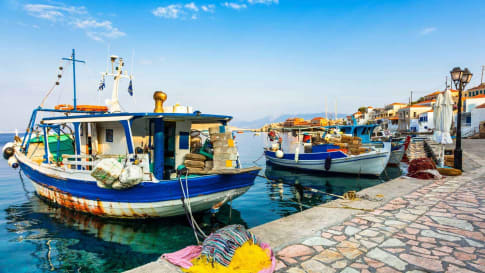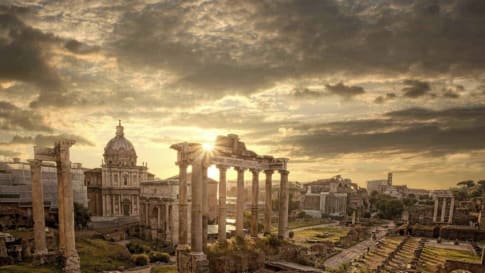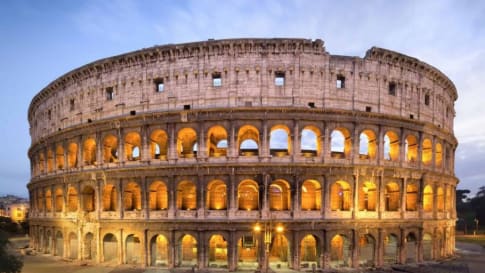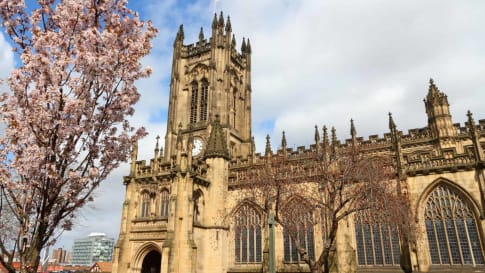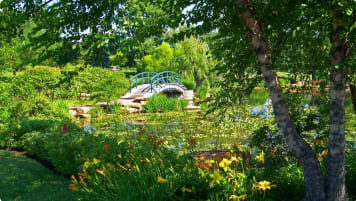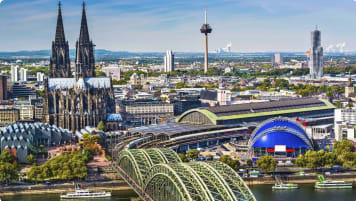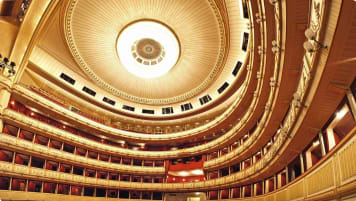Roman Britain
On this small group tour explore with a tour director and local guides the world of Roman Britain. The Romans occupied Britain for some 400 years and left behind a lasting legacy from roads Hadrian's wall to Roman Baths many are UNSECO World heritage listed.
From $13,191CAD

Highlights
- 1. Enjoy a day exploring Caerleon (Isca Augusta) in Wales, one of the largest and best preserved Roman towns in Britain.
- 2. Marvel at the Roman mosaics at Fishbourne and Lullingston.
- 3. Walk the walls and explore the forts situated on Hadrian’s mighty defensive line.
- 4. Stand on the spot in York where Constantine was first hailed as Emperor.
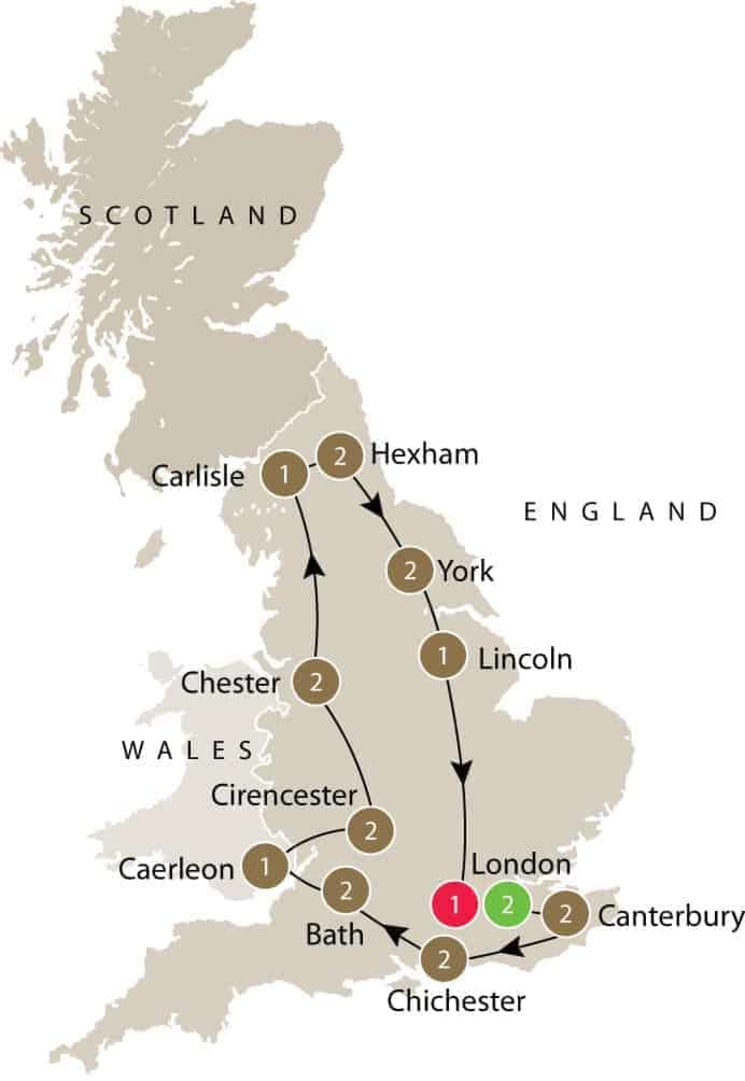
Departure Dates
| Departure Date | Price |
|---|---|
| 09 August 2025 Ends 29 August 2025 • 21 days $13,191 Twin $15,612 Single Available | Selected |
| 08 August 2026 Ends 28 August 2026 • 21 days $13,191 Twin $15,612 Single Available | |
| 07 August 2027 Ends 27 August 2027 • 21 days $13,553 Twin $15,975 Single Available |
Explore Roman Britain with Odyssey Traveller
Join Odyssey Traveller on this small group tour as we explore the world of Roman Britain, tracing the visible remains of Roman occupation in England and Wales. The Romans occupied Britain for some 400 years and left behind a lasting legacy. While many buildings were pulled down and reused there is still a lot left for us to discover. Join us as we travel in the footsteps of the Roman legions, exploring what remains of their cities, fortresses, villas, bath houses and roads.Small group tours Roman Britain itinerary
This tour begins in London, where we will travel back in time to explore Londinium, roman London, the settlement established on the current site of the city around the year 43. With a private guide we take a walking tour around the London Wall, a defensive wall built by Romans that defined the city's boundaries until the Late Middle Ages. Though the wall was demolished in the 17th century, the ruins can still be traced through private and public properties. Our London city tour also includes a visit to the remains of an ancient temple devoted to the mystery god Mithras, and a trip to the Museum of London, which houses relics of the original temple.
We then head to the charming cathedral town of Canterbury, where we see mosaics at the Lullingstone Roman Villa, a luxury villa that is believed to have belonged to the Governor of Britannia. We also take in Richborough Roman Fort, one of the most important outposts of the Romans in Britain. We then journey to Dover, where we see another important fort. In Roman times, Dover was of particular importance due to its proximity to Gaul and the European mainland.
Another highlight of the private tour is our visit to Bath, listed as a UNESCO World Heritage Site for its extensive Roman baths, along with its more recent history as a Medieval wool trading centre and Georgian spa town.
After this, we head north, stopping off in the Lake District for a visit to Ravenglass, where the soldiers from Hadrian's fleet were stationed. On this part of the tour we pass through the natural beauty of the Lakes District national park. We trace Hadrian's Wall across the United Kingdom, stopping at the fort town of Vindolanda.
We then trace our way down the east coast of England, stopping off in York, an important Roman heritage site, and Lincoln, which in Roman times rivaled London for preeminence. Finally, our guided tour ends with another night in a hotel in London.
Odyssey Traveller's tours are especially designed for senior travellers. We will be accompanied throughout the tour by an Odyssey Tour Leader. There will be local guides with specialist knowledge to assist in the presentation of information. We will always have at our disposal a comfortable modern coach with frequent stops.
If you're more interested in visiting St Paul's Cathedral, Windsor Castle and St George's Chapel, or the landscapes of the Cotswolds, check out our tours of Great Britain, ranging from basic sightseeing tours ideal for your first trip, to unique experiences that delve deep in to Britain's history and culture.
We have further information on Britain, England and Wales to assist you with choosing the right tour. You can also browse all of Odyssey's articles on Britain. We frequently publish informative content related to the tours, such as this one about Roman Roads of Britain.
For more details on this tour, click the ‘Top 5’ or ‘Itinerary’ buttons above! If you’re keen to experience this tour, please call or send an email. Or, to book, simply fill in the form on the right-hand side of this page.
Gallery
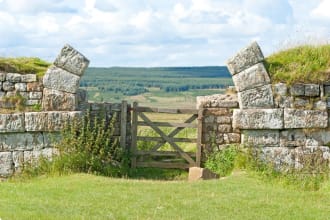
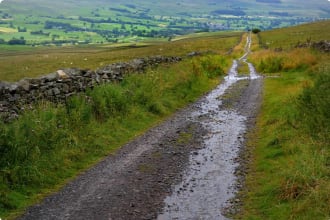
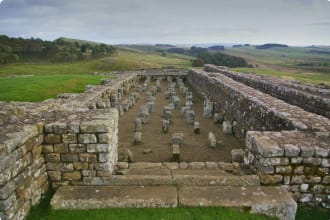
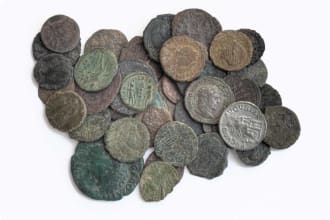

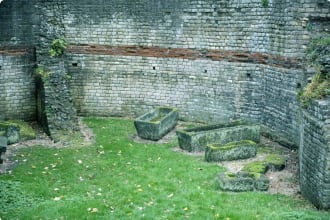
Itinerary
21 days
Day 1: London
Accommodation: London Lodge Hotel or similar
Upon arrival in London, we will make our own way to the hotel. The Odyssey Program Leader will be at the hotel to give a short introductory talk about the tour. At night we will go for a walk to a local restaurant and enjoy a welcome dinner.
Day 2: London
Accommodation: London Lodge Hotel or similar
Today we will spend the day viewing the Roman ruins in the heart of the city. For the first half of the day we will have a specialist guide with us as we walk the London Wall and view a portion of the wall underground at Spitalfields Market. The London Wall was a defensive wall built around the city when it was still the Roman port town of Londinium, and defined the city’s boundaries until the late Middle Ages. Though the wall was dismantled around the 1700s, sections of it are still visible, snaking through private and public establishments in the city of London.
After lunch (own arrangements), we will continue on our tour and view the Temple of Mithras. The remains of the temple was discovered in 1950s in Walbrook and was reconstructed for public viewing. The religion and rituals centred on the god Mithras remains a mystery, though we know the Mithraic religion was practised in Rome, especially among members of the Roman military. We will continue on to the Museum of London, which houses relics from the original temple. We will also sit down for a talk from an expert on London’s Roman history.
The rest of the evening can be spent at our leisure.
Day 3: London - Canterbury
Accommodation: The Falstaff Hotel or similar
Today we will tour by minicoach and visit London’s Roman Amphitheatre at Guildhall Art Gallery and view ancient Roman bridgework at St Magnus the Martyr church. The remains of the Roman Amphitheatre was discovered in Guildhall Yard in 1988 during an archaeological dig for the new Art Gallery building project, and was incorporated into the building’s construction work. The surviving remains include the stone entrance tunnel, east gate, and arena walls. We will visit the Billingsgate Roman House and Baths, discovered in 1848 and preserved for public view.
We will transfer by public transport to the British Museum where we will have a guided tour of Roman artefacts. Back on our coach, we will transfer to Canterbury and to our hotel.
Day 4: Canterbury - Lullingstone - Richborough - Canterbury
Accommodation: The Falstaff Hotel or similar
After a full English breakfast at the hotel, we will transfer to Lullingstone and visit the Lullingstone Roman Villa. The villa was built around 80 AD and might have belonged to the Governor of Britannia. Today we will view its mosaics, its heated bath-suite and a house-church with Christian symbols dating back to Roman times. We will also visit the galleries which display Lullingstone’s fascinating collection of Roman artefacts.
From Lullingstone we will move to Richborough to the Richborough Roman Fort and Amphitheatre. Richborough was a key site in Roman Britain, having been occupied until the end of Roman rule in the 5th century.
Back in Canterbury, we will join the Canterbury Historic River Tour, which runs for 40 minutes. On this relaxing boat tour on the River Stour, we will learn more about Canterbury’s historic past and rich architecture.
Day 5: Canterbury - Dover - Chichester
Accommodation: Crouchers Hotel or similar
After enjoying a unique vantage point of Canterbury from the river, we will now have a tour of the city on land. We will visit the Canterbury Roman Museum and will be guided by its own curator (subject to availability).
From Canterbury, we will transfer to Dover, or Dubris to the Romans, to view the Dover Castle and its Roman lighthouse. In Roman times, Dover was an important site of defence as it is closest to Gaul (France) and the rest of the European mainland.
We will transfer to Chichester and spend the night here.
Day 6: Chichester - Bignor - Fishbourne - Chichester
Accommodation: Crouchers Hotel or similar
From Chichester we will travel to Bignor to see the Roman Villa there with its stunning mosaic floors. No records exist regarding its original Roman owners, but it is currently run by the Tupper family. It was George Tupper in 1811 who discovered the villa’s remains by accident.
This is followed by a visit to the Fishbourne Roman Palace, the largest residential Roman palace discovered in Britain. We will return to Chichester and see the Roman sights of the town with a guide. The remainder of the day is free.
Day 7: Chichester - Portchester - Reading - Silchester - Bath
Accommodation: MGallery Francis Hotel or similar
After breakfast we will travel to Portchester Castle, and learn about its long history from its roots as a Roman fort in the 3rd century to a prisoner-of-war camp during the Napoleonic Wars of the 18th century.
We will stop for lunch (own arrangements) and visit the Reading Museum, which houses a gallery with artefacts excavated at the Roman town of Calleva Atrebatum, now modern-day Silchester. We will visit Silchester itself and see the Roman remains in the modern town.
From Silchester we travel to Bath, where we will spend the night.
Day 8: Bath
Accommodation: MGallery Francis Hotel or similar
The English city of Bath in Somerset was once the Roman town of Aquae Sulis. Before the Romans built their bath complex, the natural hot spring of Bath was a Celtic shrine dedicated to the goddess Sulis, from which the original town got its name. Sulis shared similarities with the Roman Goddess of Wisdom, Minerva, and when the Romans took over, they incorporated the spring into their bath complex and dedicated a temple to Sulis Minerva. We will explore this vast complex with the help of an audioguide, followed by a one-hour tour of the city of Bath.
The rest of the day is free.
Day 9: Bath - Caerwent - Caerleon
Accommodation: The Priory Hotel or similar
Our morning is free to spend at our leisure. We can use this time to explore the rest of the city, or simply rest.
From Bath we will transfer to Caerwent in south Wales to see the impressive remains of Venta Silurum, a market town established by the Romans around 75 AD and named after the Silures, the British tribe the Romans either defeated or with whom they came to an agreement.
We will transfer to Caerleon where we will spend the night.
Day 10: Caerleon - Great Witcombe - Cirencester
Accommodation: Corinium Hotel and Restaurant or similar
Caerleon was once the site of the Roman legionary settlement called Isca Augusta. Its remains are still on view, and we will visit the National Roman Legion Museum and the Caerleon Roman fortress, baths, and amphitheatre.
We return to England to view the remains of the Great Witcombe Roman Villa in Gloucestershire, built around the 250 AD near the Cotswold Way. We transfer to the town of Cirencester and spend the night.
Day 11: Cirencester - Yanworth - Cirencester
Accommodation: Corinium Hotel and Restaurant or similar
From Cirencester, we will travel to Yanworth to see the Chedworth Roman Villa, which has amazing mosaics, bathhouse rooms, and hypocaust (ancient central heating) system. From Yanworth we go back to Cirencester. With a local guide we will explore the Corinium Museum (Corinium was Cirencester’s name in Roman times) and go for a short walk to the site of a Roman Amphitheatre built in the area. The rest of the day is free.
Day 12: Cirencester - Wroxeter - Chester
Accommodation: Chester apartment accommodation
From Cirencester we will travel to Wroxeter, once the Roman city of Viriconium, and have a glimpse of Roman-era urban life in Wroxeter Roman City, which has a reconstructed town house. We will also have a tour and wine tasting at the Wroxeter Roman Vineyard.
We transfer to Chester for the night.
Day 13: Chester
Accommodation: Chester apartment accommodation
The walled city of Chester was founded as the Roman fort Deva Victrix in 79 AD. Today we will explore the city’s Roman roots with a guide. We will visit the Chester Roman Amphitheatre and visit the Grosvenor Museum. The museum takes its name from the family name of the Dukes of Westminster, major landowners in Cheshire. It houses archaeological items from Roman times.
We will also visit the Dewa Roman Experience, a tourist attraction offering an immersive, multisensory presentation of Roman Britain.
The remainder of the day is free.
Day 14: Chester - Ravenglass - Hard Knott - Carlisle
Accommodation: Crown and Mitre Hotel or similar
We will travel to Ravenglass, a coastal town in the Lake District, to visit the remains of the Ravenglass Roman Bath House, established in 130 AD, where soldiers from Hadrian’s fleet were stationed. A Roman road once linked the bath house to the fort in Hard Knott, which we will visit next. Please note that reaching the fort requires a short uphill climb.
From Hard Knott we will transfer to Carlisle.
Day 15: Carlisle - Gilsland - Greenhead - Hexham
Accommodation: BW Beaumont Hotel or similar
Carlisle was established as a prominent Roman stronghold, and today we will visit Tullie House Museum and Gallery to view the Roman Frontier, a permanent exhibition showcasing the museum’s extensive Roman collections, some on loan from the British Museum. The Roman Frontier Gallery also includes mixed-media displays and experience-based interactive exhibits.
We transfer to Gilsland to view the Birdoswald Roman Fort, the remains of Hadrian’s Wall, a defensive fortification built around 122 AD and which runs a total of 117.5 kilometres (73 miles) in northern England.
In Greenhead, we will visit the Roman Army Museum, which stands next to Walltown Crags, one of the highest standing sections of Hadrian’s Wall.
We will transfer to Hexham for the night
Day 16: Hexham - Vindolanda - Housesteads - Chollerford - Hexham
Accommodation: BW Beaumont Hotel or similar
Today we will venture out of Hexham to visit the Roman Vindolanda, one of Europe’s most important Roman archaeological sites. This is where the Vindolanda tablets were unearthed. The tablets, containing letters written by Roman soldiers stationed at the fort of Vindolanda from 85 to 130 AD, are the oldest surviving handwritten documents in Britain. We will continue to follow Hadrian’s Wall and visit the Housesteads Roman Fort and the Chesters Roman Fort in Chollerford. We return to Hexham for the night.
Day 17: Hexham - Corbridge - Newcastle - York
Accommodation: Hotel 53 or similar
After visiting many guarded fortresses, we will now visit Corbridge Roman Town, which was a bustling town and supply base during Roman times and which will give us a glimpse of Roman civilian life. It houses the largest collection of material from Hadrian’s Wall.
In Newcastle, we will visit the Great North Museum: Hancock, which houses the Hadrian’s Wall gallery containing a wealth of archaeological finds.
We will spend the night in York.
Day 18: York
Accommodation: Hotel 53 or similar
We will spend the day exploring York, founded as Eboracum by the Romans in 71 AD. We will view the sites with a local guide and see York Minster, one of the largest cathedrals in Northern Europe, and the statue of Emperor Constantine.
The remainder of the day is free for us to enjoy.
Day 19: York - Lincoln
Accommodation: The Lincoln Hotel or similar
After having our fill of York, we will transfer to Lincoln, which rivalled London in importance as a Roman town. With a local guide we will view the Roman sites of the city, including Castle Hill, the Roman Well, Mint Wall, and the Newport Arch, which is believed to be the only Roman arch still used by traffic. We will step into the award-winning archaeology museum, The Collection. The rest of the day is free.
Day 20: Lincoln - St Albans - London
Accommodation: London Lodge Hotel or similar
From Lincoln, we will travel to St Albans to explore the city’s Roman past. The sites we will visit include the Verulamium Museum, the Roman Theatre, and hypocaust.
We return to London, and meet once again as a group for our farewell dinner.
Day 21: London
The end of breakfast also marks the end of the tour and our services.
Includes / Excludes
What’s included in our Tour
- 20 nights accommodation.
- Breakfast daily and other meals as listed in the itinerary.
- All excursions, entrance fees, and local guides.
- Transport in comfortable and modern coaches.
- Services of a Tour Leader for the duration of tour.
- Gratuities and necessary tips.
What’s not included in our Tour
- International airfares and departure taxes.
- Comprehensive travel insurance.
- Items of a personal nature such as telephone calls and laundry.
Participants must be able to carry their own luggage, climb and descend stairs, be in good health, mobile and able to participate in 3-5 hours of physical activity per day, the equivalent of walking / hiking up to 8 kilometers per day on uneven ground.
Book now
Make it a private tour
Easing your journey
Crossing international borders with restrictions
The list of requirements to travel internationally has changed and will continue to change for several years. Odyssey is here to assist you in managing your way through these requirements:
For more information see our Crossing international borders with restrictions page.
Book With Confidence
If less than 30 days before your tour starts you are unable to travel as a result of Government travel restrictions, Odyssey Traveller will assist you with a date change, provide you with a credit or process a refund for your booking less any non-recoverable costs.
See Terms and conditions for details.
Peace of Mind Travel
The safety of our travellers, tour leader, local guide and support staff has always been our top priority and with the new guidelines for public health and safety for keeping safe for destinations around the world, we’ve developed our plan to give you peace of mind when travelling with us.
See Peace of Mind Travel for details.
Reading List Download PDF
An Imperial Possession: Britain in the Roman Empire, 54 BC - AD 409
David Mattingly
Part of the Penguin History of Britain series, An Imperial Possession is the first major narrative history of Roman Britain for a generation. David Mattingly draws on a wealth of new findings and knowledge to cut through the myths and misunderstandings that so commonly surround our beliefs about this period. From the rebellious chiefs and druids who led native British resistance, to the experiences of the Roman military leaders in this remote, dangerous outpost of Europe, this book explores the reality of life in occupied Britain within the context of the shifting fortunes of the Roman Empire.
Roman Britain: A New History
Guy de la Bédoyère
This illuminating account of Britain as a Roman province sets the Roman conquest and occupation of the island within the larger context of Romano-British society and how it functioned.
The author first outlines events from the Iron Age period immediately preceding the conquest in AD 43 to the emperor Honorius’s advice to the Britons in 410 to fend for themselves. He then tackles the issues facing Britons after the absorption of their culture by an invading army, including the role of government and the military in the province, religion, commerce, technology, and daily life. For this revised edition, the text, illustrations, and bibliography have been updated to reflect the latest discoveries and research in recent years.
The superb illustrations feature reconstruction drawings, dramatic aerial views of Roman remains, and images of Roman villas, mosaics, coins, pottery, and sculpture.
Britain After Rome: The Fall and Rise, 400 to 1070
Robin Fleming
The enormous hoard of beautiful gold military objects found in a field in Staffordshire has focused huge attention on the mysterious world of 7th and 8th century Britain. Clearly the product of a sophisticated, wealthy, highly militarized society, the objects beg innumerable questions about how we are to understand the people who once walked across the same landscape we inhabit, who are our ancestors and yet left such a slight record of their presence. Britain after Rome brings together a wealth of research and imaginative engagement to bring us as close as we can hope to get to the tumultuous centuries between the departure of the Roman legions and the arrival of Norman invaders nearly seven centuries later. As towns fell into total decay, Christianity disappeared, and wave upon wave of invaders swept across the island, it can be too easily assumed that life in Britain became intolerable—and yet this is the world in which modern languages and political arrangements were forged, a number of fascinating cultures rose and fell and tantalizing glimpses, principally through the study of buildings and burials, can be had of a surprising and resilient place. The result of a lifetime of work, Robin Fleming's major new addition to the Penguin History of Britain could not be more opportune. A richly enjoyable, varied, and surprising book, Britain after Rome allows its readers to see Britain's history in a quite new light.
The Roman Invasion of Britain
Graham Webster
In AD 43 - almost 100 years after Julius Caesar's punitive expedition - Britain was invaded for the second time. Using the full range of historical and archaeology sources, this book explores the background to the invasion, describes the actual landings and details the shape of the new province.
Graham Webster is one of Britain's most eminent archaeologists, with a long and distinguished career which earned him an OBE.


